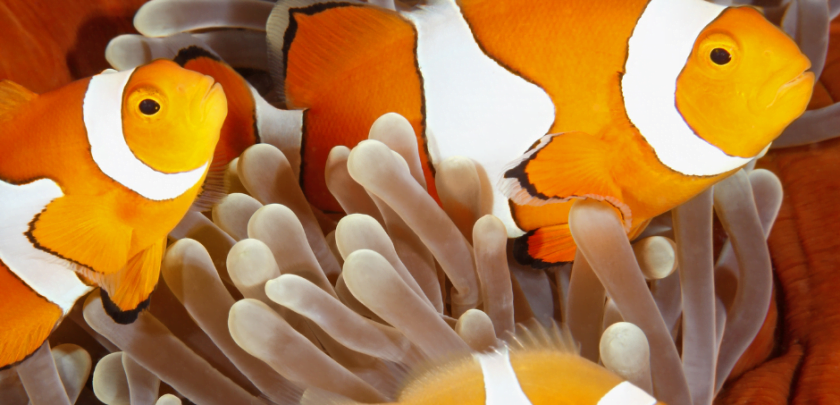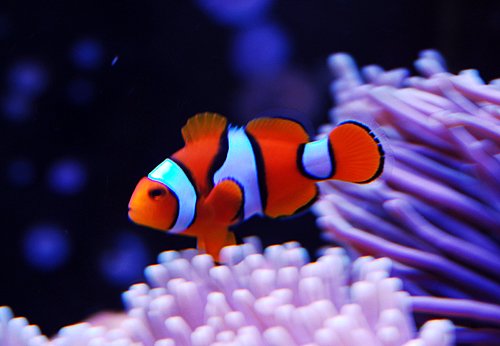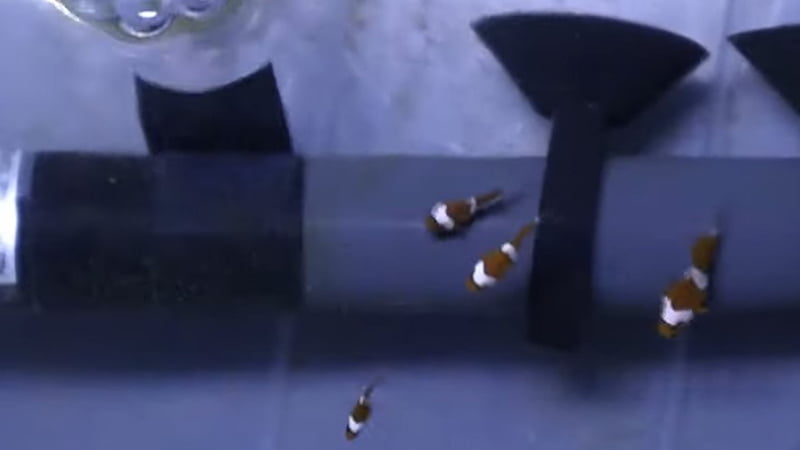Feeding baby clownfish is a fun and rewarding experience. Clownfish are an important part of the marine ecosystem, feeding on algae that grow in coral reefs and other underwater habitats. Like all fish, clownfish need to be fed every day. Most people feed them by putting food into their tanks or feeding them from the outside with tongs or nets, but there are some other ways to feed your little friends!
The feeding process for baby clownfish is not difficult, but it does require a little planning. In this blog post, we will discuss the feeding process and how to go about feeding your tiny fish.
See also:
- What Do Clownfish Eggs Look Like? (Top 3 Different Facts).
- 3 Interesting Facts About How Clownfish Laying Eggs
- Do Clownfish Eat Their Babies And Eggs? (Amazing Fact)
Feeding Baby Clownfish
Rotifers are required for the survival of freshly born larvae, as previously stated. They don’t eat rotifers in the wild; instead, they eat plankton and microorganisms that naturally reside in the ocean. We employ rotifers since we can’t simply replicate this plankton.
There is no other readily available source of food for clownfish larvae. When they are initially hatched, they will not consume dry foods, and other live meals, such as recently hatched brine shrimp, are too huge for them.
For the first 10 days of their existence, the larvae will require a steady supply of rotifers. If you like, you can start feeding freshly hatched brine shrimp around day 5. It is, however, unnecessary, and it is simpler to just switch from rotifers to dry food.
TDO – A, which is top-dressed Otohime, should be the first dry food provided. Simply put, this is a high-quality Japanese fish meal mixed with additional ingredients to promote fish health and colour. On or after day 3, TDO – A should be given. Initially, it would be best if you continued to feed rotifers. However, the concentration of rotifers in the water can be reduced. You’ll be able to see if the larvae are consuming the TDO or not when you feed them. You can stop adding rotifers to the water once it’s apparent that they’re destroying the TDO.
You can start mixing TDO – A and TDO – B1 after around four days of TDO – A. Feed a combination of both for three more days, then only B1 until the fish are around two weeks old.
You can start introducing additional meals like ground flakes and pellets at this point. The easiest method to achieve this is to invest in a mortar and pestle, which are both affordable and effective. These could be available at your local drugstore or on Amazon (like this one).
You may gradually add bigger meals, like coarsely powdered pellets or flakes mashed with your fingers, as they develop (about 1 month old). There are additional fish meals developed specifically for infants, as well as TDO – C2.
What Should Feeding Baby Clownfish When They Hatch?
The freshly born larvae are too tiny to eat brine shrimp nauplii and will need to be fed rotifers; the ideal species is Brachionus Picatilis, a marine rotifer. Specialist providers, some of whom are named at the conclusion of this page, may provide starter cultures of this rotifer and its food supply, single-celled sea algae of the species Isochrysis Galbana or Pavlova lutherie. To get the needed amounts, these cultures will need to be replicated well in advance, which can be more difficult than producing the larvae themselves!
Once the larvae have hatched, they will begin to feed almost immediately, allowing you to introduce a variety of rotifers to the tank. Because the larvae will not swim far for food, rotifers must be present in every section of the tank to avoid contamination.

As a general rule, feeding will be necessary every 2-3 hours for the first four days. This includes the hours of darkness and the purpose of using a pygmy bulb to light the tank. These unsociable feeding hours may appear pointless, yet they create the most powerful and colorful fish. Poor feeding regimens with low-quality cultures at the larval/fry stage generally result in pale, feeble specimens on the market.
After four days of only eating rotifers, the fry will be large enough to eat brine shrimp nauplii. Because newborn brine shrimp develop so quickly, the greatest results are obtained when they are just a few hours old. For the following five days, stick to this routine. The feedings can gradually be lowered to one every 4-6 hours, but the fry must always have full and obviously bloated tummies. According to one idea, if the stomach is left empty for too long, the lining of the stomach fuses together, causing irreversible harm. As a result, even when food becomes available, the fish will be unable to digest it correctly.
After nine days of mixed rotifer/brine shrimp feeding, the rotifers can be entirely removed and replaced with a brine shrimp/pulverized flake food combination.
Enrich Baby Brine Shrimp To Feeding Baby Clownfish
So your clownfish has reproduced, and the eggs appear to be ready to hatch. Matt Pedersen, a marine specialist, offers some suggestions for feeding the infants and nourishing young brine shrimp for a marine fish fry.
In reality, gut loading of young brine shrimp (also known as Artemia nauplii) may not be essential, but it surely won’t harm. Some juvenile clownfish can be weaned directly from enriched rotifers to rotifer-sized larval diets like Otohime A. I’ve used such larval diets as early as 4-5 days after hatching while keeping rotifers until the larvae are fully weaned, and I’ve even managed to grow clownfish without utilizing brine shrimp nauplii at any point.
At least one commercial clownfish incubator in the United States does not hatch young brine shrimp for any of its clownfish. But just because you “can” doesn’t imply you “should” or that it’s the best way to go about it! Baby brine may also be required to trigger a feeding response in other marine fish babies.
I should explain why newborn brine shrimp may need to be gut-loaded or enriched. Brine shrimp is not a real “marine” species, to put it simply. As a result, they do not natively possess the high quantities of DHA found in marine animals such as Copepods. All species of larval marine fish require DHA and EPA for optimal growth.
When these HUFAs (Highly Unsaturated Fatty Acids) are lacking in the larval diet, infants are more likely to succumb to shock-related fatalities. This is known as SFS (Unexpected Fright Syndrome), and any sudden stimulus can cause the young fish to become shocked, drop to the bottom, quiver, and possibly die.
Because the prepared meals include the essential HUFAs, transferring clownfish directly from rotifers to prepared larval diets helps to avoid SFS. There’s no reason you can’t feed your baby clowns both larval diets and baby brine shrimp simultaneously.
Newly born brine shrimp cannot be “enriched.” The initial stage after hatching is called “Instar I,” and the nauplii has no mouth at this stage. In other words, because it is unable to feed, it cannot be gut-filled. You can “soak” this stage in a HUFA solution like Super Selcon, but the most you can hope for is that some of the enrichment solutions stick to the young brine shrimp’s exterior and are ingested by the baby fish.
Due to their small size, you may need to start giving Instar I nauplii right away – waiting too long to nourish the young brine shrimp might result in a nauplius that is too large to feed on, and “Instar I” is calorie-wise superior to “Instar II.” Until the juvenile fish are large enough to tolerate the following stage, soaking will be your only choice.

You must wait for the young brine shrimp to develop and molt into Instar II because Instar I does not feed. This stage will take around 12 hours to achieve after hatching. The newborn brine shrimp can now begin to consume enrichments such as Super Selcon or phytoplankton (you can use live phytoplankton or any number of prepared phytoplankton products).
Depending on whatever source you consult, the real amount of time required to enhance differs. Given that brine shrimp do not always hatch at the same time, adding enrichments six hours after hatching and harvesting the nauplii for usage 14-16 hours after hatching is the ideal strategy. You may also want to look up the manufacturer’s specific directions for enhancing their product.
The primary line is that brine shrimp nauplii are a somewhat more deficient diet for young marine fish. However, it is considerably more complex and demanding to give at this time; using copepod nauplii when possible would be far more helpful (and it is known to be necessary). Thankfully, clownfish are “forgiving,” and a week or two of larval feeding with young brine shrimp is all that is required.
FAQs
How do you feed small clownfish?
Shrimps like Krill, Mysis, and Brine are the most incredible live meals to give your Clownfish.
How often should you feed baby clownfish?
Feeding your Clown or Damsel: Feed tiny quantities 1 to 2 times daily. No more than the fish would consume in 1 to 2 minutes, depending on species and size.
Do clownfish kill their eggs?
In a regular aquarium, any eggs that hatch will be consumed or destroyed by your filtration system.

Annette M. Chaney is an experienced marine biologist with over 20 years of experience as an aquarist and fishkeeper. She started her first aquarium at a young age, filling it with frogs and goldfish obtained from the ten-cent pet store.
Annette grew up caring for and breeding African Cichlids, which led to a hobby in high school that doubled as a profitable means. Attending Reed College gave her time to solidify herself as an accomplished aquarium caretaker with an eye for sales. After that, from 2009 – 2013, she studied at Roger Williams University – one of the most prestigious universities for Aquaculture and Aquarium in USA. She is the founder of AquariumCircle since 2010.
